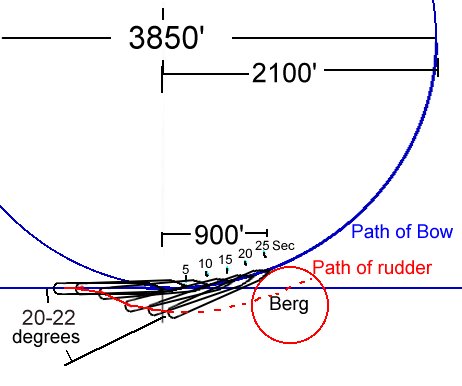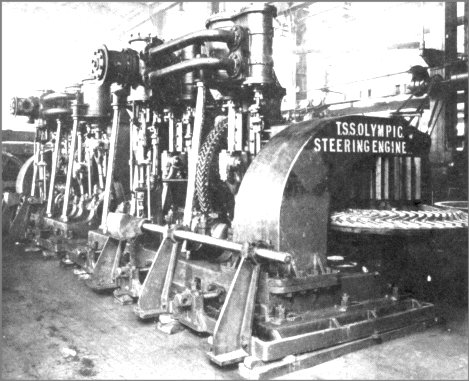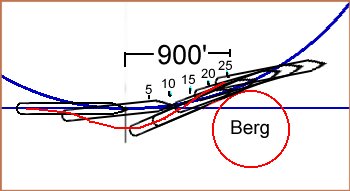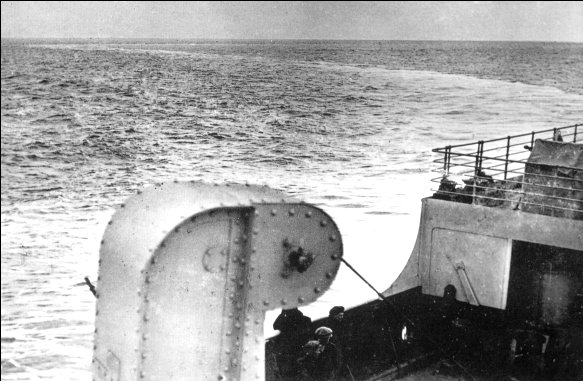|
|
|
Titanic and the Iceberg
|
|
By Roy Mengot
|
|
-
It's been
popular lore in the Titanic story that the
iceberg was spotted 37 seconds before
impact and the ship was too large and
under ruddered to avoid it. This may not
have been the actual fact on the night of
April 14, 1912. A willingness to believe
Titanic couldn't turn quickly may have
served Harland & Wolff and the White
Star Line to hide the fact that the berg
simply wasn't seen until Titanic was
nearly on top of it.
A key definition in
understanding the testimony is the
nautical term 'point'. To describe where
an object is relative to the ship, 90
degrees is divided into eighths. "4 points
off the port bow" is 45 degrees left of
the direction of travel. Two points is
22.5 degrees but people can picture half
of a 45 degree angle easier than they can
work with compass degrees.
The origin of the 37
second figure came when Edward Wilding of
Harland & Wolff and a designer of the
Olympic class ships testified on day 27
before the British inquiry:
25292. Does that
complete the information? - No, there is
a little more information that I think
the Court wishes to have. Since the
accident, we have tried the "Olympic" to
see how long it took her to turn two
points, which was referred to in some of
the early evidence. She was running at
about 74 revolutions, that corresponds
to about 21 1/2 knots, and from the time
the order was given to put the helm hard
over till the vessel had turned two
points was 37 seconds.
25293. (The
Commissioner.) How far would she travel
in that time? - The distance run by log
was given to me as two-tenths of a knot,
but I think it would be slightly more
than that - about 1,200 or 1,300 feet.
Given the speed,
Wilding's numbers for the distance
covered, with some addition drag caused by
the turn, are correct. However, the 37
second time for Olympic is not consistent
with the numbers for Titanic's trials in
the high speed turn. In fact, 37
seconds for 2 points is almost 50%
greater than what Titanic achieved in
her trials off Belfast Lough. His
calculation of 12-1300 feet has also
reenforced the belief that the berg was
spotted at a distance of a quarter mile
(400 meters).
The 2 points of turn
is significant because it helps to
determine how far away the fatal iceberg
was when it was first sighted.
Quartermaster Hitchens was at the wheel of
Titanic during the collision, and while
there were inconsistencies in his
testimony, he remained consistent on the
ship achieving 2 points of turn before the
collision started. Fred Fleet in the
crow's nest also thought the ship had one
or two points of turn in his testimony. Of
the survivors in a position to observe the
events, these two men are the only ones to
comment on the turn.
Plotting Titanic's
trials sheds some light on the
maneuverability of the ship. In a standard
maneuver, Titanic was cruising at nearly
full speed, 21.5 knots, and upon passing a
marked point, went into a full hard turn
and the turning radius was measured. The
results showed a 3850' diameter circle
(1174 meters). The forward movement of the
ship was 2100 feet (640 meters) or about
10% more than the radius of the circle.
This was due to the slightly sluggish
start as the rudder was turned and began
to dig in to throw the stern outward as
the ship worked into a full turn.
Figure 1 shows the
turning radius of the circle and includes
the 10% extended curvature on the forward
side of the circle, although it is barely
perceptible. A circle with a diameter of
3850 feet has a circumference of 12,100
feet (3688 meters) and traveling at 21.5
knots or 35.5 feet (10.8 meters) per
second, Titanic traversed the circle in
5.6 minutes (340 seconds). On average, 360
degrees in 340 seconds is just under 1
degree per second.
-
|
|

|
|
Figure 1 - Turning 2 points to the
collision point
|
|
-
|
|
Plotting the tuning
radius out in scale reveals a few
interesting things:
1) The berg as drawn
is roughly 660 feet (200 meters) in
diameter. Since it is not known how large
the berg actually was, it doesn't matter
how large we draw it. For an iceberg
approaching the sizes described in
testimony, Titanic was left of its center,
hence Murdoch ordered a left turn around
it.
2) Getting two points
of turn on the ship can be achieved in
about 25-30 seconds (conservative
estimate) by the data from the trials.
3) It takes 25
seconds to pass the full length of the
ship past a given point at 21.5 knots.
4) At full turn, the
rudder post is about 75 feet (23 meters)
outside the circle made by the tip of the
bow.
Of particular
interest from the testimony was Hitchens'
statement that he turned the ship to port
and scarcely had the helm over when the
collision began. After follow-up
questions, he admitted the helm was full
over when the collision started. He
further stated that he had 'two points' of
turn. Frederick fleet testified the ship
was already turning while he was on the
phone to the bridge, indicating that the
bridge had seen it at about the same time
and was already in action.
How fast could
Titanic turn its rudder? The steam powered
steering gear atop the rudder under the
poop deck consisted of a primary and
back-up steam engine controlled from the
helm on the bridge or docking bridge. The
steam engine turned gears that could turn
the rudder 60 degrees off center in the
desired direction. From evidence to
follow, Titanic appears to have been able
to get the rudder full over from center in
5-7 seconds.
-
|
|

|
|
Figure
2 - The steam driven steering
gear of the Olympic class ships
|
|
-
|
|
The Porting
maneuver
With the stern
swinging out so wide during a turn on such
a long ship, a maneuver had to be executed
to keep the ship from grinding into the
berg over it's hole length. In the Titanic
scenario this is called 'porting' the ice
berg. To turn left to avoid the berg, 1st
officer Murdoch gave the order 'Hard a
starboard', which meant to starboard the
helm as in an old fashioned tiller, which
was turned opposite the direction you
wanted to go. To swing the stern left and
turn the ship to the right, a 'hard a
port' order would be given. Thus 'porting'
the stern means giving the command to turn
the tiller to port (which turns the ship
right).
Figure 3 indicates
how this maneuver would appear. The blue
line is the turning radius of the ship and
the red line indicates the path of the
rudder post at the stern if the 'hard a
port' command were given the instant
contact with the berg began. Compare the
path of the rudder to Figure 1 if no
porting maneuver was attempted.
-
|
|

|
|
Figure 3 - 'Porting the
ship' around the iceberg
|
|
-
|
|
When asked at the
British hearings, Quartermaster Hitchens
denied there was a command to turn to
starboard. It's not clear if Hitchens
thought they were asking if the ship
initially turned right or if they asked
about a subsequent porting maneuver. He
volunteered no information and may have
been coached to only answer the question
put to him and say nothing else.
Quartermaster Olliver stated at the US
hearings that the ship was executing a
porting maneuver when he entered the
bridge just after the collision and he
went outside and saw the ship swinging
away from the berg. Seaman Scarrott at the
British hearings also testified he saw the
stern swinging away before the stern had
cleared the iceberg.
What does this say
about the maneuverability of the ship? As
mentioned, it takes 25 seconds for the
ship to pass a given point. If Titanic's
helm was hard over in the turn to port,
then in the next 15 or so seconds after
the start of the collision, the helm was
thrown all the way over in the opposite
direction and the rudder responded. This
indicates that the rudder could be turned
hard over from center in 5-7 seconds.
Bringing the rudder back to center will
stop the turn more quickly as the water
flow aids in straightening the ship.
Getting even part of a turn in the last
7-10 seconds before the berg went astern
of the ship would suffice in clearing the
stern.
The following photo
was taken by Father Browne during the run
to Queenstown. The ship performed some
lazy-S turns to swing the compasses. As
can be seen by the wake, Titanic appears
to be turning nicely.
-
|
|

|
|
Figure
4 - Titanic performing turns
between Cherbourg and Queenstown
|
| - |
|
The retarded turn to
port upon sighting the ice is not
consistent with the responsiveness of the
ship in the subsequent turn to starboard.
|
| - |
|
Effectiveness
of lookouts
On
a dark moonless night, the main way to
spot an iceberg is by water breaking
around the base. This was not possible for
Titanic due to the extraordinarily calm
weather. While ice bergs generally appear
white, frost diffuses light. If little
light is reaching the berg, then even less
is reflect back to the viewer.
One
of the ways objects are spotted from a
ship is if the form partially blots out
the sky or distorts the horizon. Eye level
from Titanic's crow's nest was about 24
feet (7.3 meters) higher than the bridge.
While this extends the line of sight to
the horizon by a few miles, it had the
side effect that objects on the water will
be below the horizon out to a greater
distance as well. A 70' (21 meter) iceberg
will be below the horizon from the crows
nest for about 3 miles (5 km) from the
ship. From testimony, it appears that
Murdoch on the bridge saw the berg about
the same time the lookouts reported it.
Fred Fleet testified that the ship was
already turning while he was on the phone
to report it.
Captain
Lord on the Californian testified that he
had little experience with ice and all the
reports placed ice along his more
northerly route to Boston. Despite his
admitted ignorance of ice, he placed two
additional lookouts; one on the mast above
the crow's nest and another of the prow of
the ship, lower than the crows nest. As a
testament to the darkness, Californian had
to turn sharply to avoid icebergs, even
though they were going a little more than
half Titanic's speed and had the extra
eyes looking for them. He subsequently
decided to stop for the night.
Engine
effects
4th
officer Boxhall testified that he thought
the engines had been reversed when he
arrived on the bridge moments after the
collision. All of the testimony from
several crewmen down in the engine spaces
indicate a stop order was received, but
the engines were not stopped or reversed
before the collision began. This indicates
that the rudder was receiving the full
benefit of water flowing past from the
ship's speed and the action of the center
propeller.
It
has been discussed that reversing the
engines would have the effect of reducing
rudder effectiveness by interrupting the
flow of water passing the rudder and
removing the force of water coming off the
center prop. While it's not stated as a
condition in Wilding's testimony about the
37 seconds, if the turning exercise
with Olympic also involved reversing the
engines as per Boxhall's scenario, then
the discrepancy between Titanic's
turning performance at the trials and
Olympic's performance can be explained.
The initial loss of speed from reversing
the engines on Olympic would be minimal,
as Titanic's trials also indicated it
would take over three minutes to stop the
ship from full speed.
It
has also been discussed that reversing one
engine would aid in turning the ship.
While this is true, it doesn't become an
issue in the Titanic scenario. Murdoch
knew he needed to turn and then swing back
the opposite way to clear the stern.
Reversing one engine to help the turn to
port would then hamper the swing back to
starboard. Avoiding the obstacle requires
two turns. In any event, time was too
short for a complicated maneuver such as
tampering with the engines. Even the order
to stop could not be carried out in time.
Conclusions
37 seconds does not
fit the profile of Titanic's turning
radius at the trials. A two point turn
could be accomplished in something nearer
25 seconds, assuming the ship achieved a
full two points of turn. This translates
to spotting the ice berg at 900 feet (250
meters) or less rather that 12-1300 feet
(400 meters). Actions on the timeline for
the collision, such as Fleet phoning the
bridge, may have been done in parallel
with turning the ship, shortening the
timeline. Ultimately, this indicates that
the lookouts and Murdoch could not see the
berg until they were almost on top of it.
At the hearings, the White Star Line and
surviving crew were perfectly happy with
all the speculation that the ship was
under ruddered and unmaneuverable. This
speculation, that continues to this day,
just hides the fact that the crew just
flat couldn't see even large objects and
the margin for safety at their speed
wasn't there under the conditions of that
night. Despite the clear conditions, a
reduction in speed was warranted due to
the extraordinary darkness.
|
| - |
|